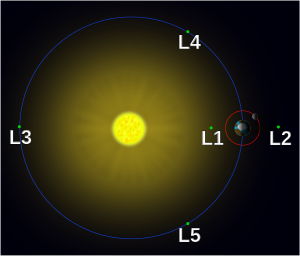Distant retrograde orbit

A distant retrograde orbit (DRO), as most commonly conceived, is a spacecraft orbit around a moon that is highly stable because of its interactions with two Lagrange points (L1 and L2) of the planet-moon system.
In more general terms, an object of negligible mass can be in a DRO around the smaller body of any two-body system, such as planet–Sun or exoplanet–star.
Using the example of a spacecraft in a DRO around a moon, the craft would orbit in the direction opposite to the direction in which the moon orbits the planet. The orbit is "distant" in the sense that it passes above the Lagrange points, rather than being near the moon. If we consider more and more distant orbits, the synodic period (the period between two moments when the craft passes between the planet and the moon) gets longer and approaches that of the moon going around the planet, so that the sidereal period (the time it takes for the craft to come back to a given constellation as viewed from the moon) can become much longer than the orbital period of the moon. A hypothetical example with Europa has a sidereal period about eight times the orbital period of Europa.[1]
DROs have been researched for several decades, but as of 2021, no spacecraft had used such an orbit for an actual flight. In early 2022, it was speculated that the Chang'e 5 orbiter may have now done so.[2]
Description
The stability of a DRO is defined in mathematical terms as having very high Lyapunov stability, where an equilibrium orbit is "locally stable if all solutions which start near the point remain near that point for all time."[1]
List of Objects in Distant retrograde orbit
Chang'e 5 orbiter
China's Chang'e 5 (CE-5) orbiter, which according to The Space Review (TSR) may have moved to a lunar distant retrograde orbit by January 2022, could be conducting very-long-baseline interferometry (VLBI) tests to support Chinese preparations for the next stage of China's Lunar Exploration Program (CLEP). The analysis by TSR was based on statements made by Chinese government information and Chinese academics.[2][needs update] If the move to DRO was actually made, then Chang'e 5 would be the first spacecraft to actually enter a distant retrograde orbit to test the DRO theoretical result.
Space concepts proposed to use a DRO
NASA Asteroid Redirect Mission (ARM)
By 2014, a lunar DRO was the preferred alternative under consideration for the NASA-proposed Asteroid Redirect Mission (ARM). This orbit would have had a lunar orbital altitude of approximately 61,500 km (38,200 mi), a distance somewhat greater than the distance from the Moon to either of the Earth-Moon L1 or L2 Lagrangian points.[1] NASA subsequently cancelled work on ARM in 2017 and never funded the build of flight hardware nor issued any space launch contracts.[3]
Jupiter Icy Moons Orbiter
A distant retrograde orbit was one of the proposed orbits around Europa for the Jupiter Icy Moons Orbiter—principally for its projected stability and low-energy transfer characteristics—but that mission concept was cancelled in 2005.[1]
NASA Lunar Gateway
Two system requirements for the NASA Lunar Gateway mention[when?] the use of lunar DROs. Requirement L2-GW-0029, Single Orbit Transfer, states "the Gateway shall be capable of performing a single round trip transfer to Distant Retrograde Orbit (DRO) and back within 11 months." Requirement L2-GW-0026, Propulsion System Capability, states "the Gateway shall provide a fuel capacity that would support performing a minimum of two round-trip uncrewed low-energy cislunar orbit transfers between a near-rectilinear halo orbit (NRHO) and a distant retrograde orbit (DRO) and orbit maintenance for a period of 15 years between refueling."[4]
NASA will test the theory of DRO in November 2022, on the initial test flight for the NASA Space Launch System (SLS) launch vehicle (in development since 2010[5]) and the NASA Orion space capsule (in development since 2005),[6]) where NASA has selected a DRO as a part of the first Orion deep space test mission, named Artemis 1. Previously planned to use a circumlunar trajectory for its lunar test flight, by late 2015 NASA had replanned the first deep space test of the uncrewed Orion capsule to use a distant retrograde orbit, with the Orion spacecraft slated to spend approximately three weeks in space, including six days in a DRO around the Moon.[7]
DRO orbits in fiction
In the 2019 Daniel Suarez novel Delta-v, a 560-tonne crewed asteroid-mining ship The Konstantin is constructed in a lunar DRO approximately 40,000 km (25,000 mi) above the Moon.[8]
See also
References
- ^ a b c d Johnson, Kirstyn (18 December 2014). "Understanding NASA's Asteroid Redirect Mission : Distant Retrograde Orbits". Archived from the original on 11 January 2015. Retrieved 3 May 2015.
- ^ a b Burke, Kristin (11 April 2022). "The Space Review: What is China doing at the lunar distant retrograde orbit?". The Space Review. Archived from the original on 2022-04-12. Retrieved 2022-04-12.
- ^ Foust, Jeff (14 June 2017). "NASA closing out Asteroid Redirect Mission". SpaceNews. Archived from the original on 15 June 2017. Retrieved 3 November 2019.
- ^ "DSG-RQMT-001 - Gateway Program System Requirements Document (SRD)" (PDF). NASA Technical Reports Server. National Aeronautics and Space Administration (NASA). 2019. p. 25. Archived (PDF) from the original on 11 April 2020. Retrieved 11 April 2020.
- ^ Smith, Marcia (14 September 2011). "New NASA Crew Transportation System to Cost US$18 Billion Through 2017". Space Policy Online. Archived from the original on 2 April 2015. Retrieved 15 September 2011.
- ^ "Exploration Systems Architecture Study – Final Report" (PDF). NASA. November 2005. NASA-TM-2005-214062. Archived from the original (PDF) on October 13, 2006. Retrieved July 6, 2009.
- ^ "The Ins and Outs of NASA's First Launch of SLS and Orion". NASA. 27 November 2015. Archived from the original on 22 February 2020. Retrieved 3 May 2016.
- ^ Suarez, Daniel (2019). Delta-v. New York: Penguin Random House. pp. 189–198. ISBN 978-1524742416.
